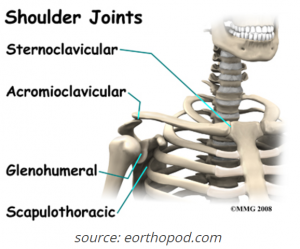by Doctor of Physical Therapy Troy Vander Molen
 Shoulder pain is a common problem. People with shoulder pain are the third most common clients we serve at our clinics. In fact, over the past three years, we’ve had nearly 10,000 treatment sessions dedicated to shoulder issues. That’s a lot of shoulder pain!
Shoulder pain is a common problem. People with shoulder pain are the third most common clients we serve at our clinics. In fact, over the past three years, we’ve had nearly 10,000 treatment sessions dedicated to shoulder issues. That’s a lot of shoulder pain!
The shoulder is prone to issues because it is an extremely mobile ball-and-socket joint. The mechanics of the shoulder are complex, but seem to take that for granted until we experience pain.
To understand the shoulder, we must first realize that the shoulder joint is really a shoulder complex made up of four different connection points or joints (Figure 1). Because the scapulothoracic joint connects to the spine and rib cage through muscles, the only bone-to-bone connection between the shoulder complex and the trunk is through the sternoclavicular joint where the collar bone connects to the breast bone.

Most shoulder problems occur beneath the acromioclavicular (AC) joint in an area known as the sub acromial space. Through that space travel important rotator cuff tendons and a bursa, which provides cushion.
Imagine what happens to that limited space when you raise your arm. As the upper arm elevates, the sub acromial space can experience compressive forces that add pressure to those tissues. And unfortunately those tissues are prone to irritation because they are not well-endowed with the important flow of blood that provides nutrition to the tissues and removes waste.
When those tissues experience too much physical stress, we experience “itis” issues like tendinitis and bursitis.
If the shoulder functions well, however, the pressure does not build and inflammation isn’t experienced. That’s because the upper arm and the remainder of the shoulder complex is designed to “dance.” In other words, when the upper arm bone moves, the rest of the shoulder is supposed to move with it. This dance results in a relatively consistent amount of space within the sub acromial region and pinching forces are almost non-existent.
The dance doesn’t always occur as designed, and like most musculoskeletal problems, the thing that hurts – in this case, the tissues within the sub acromial space – suffers because a close neighbor isn’t taking care of some of its responsibilities.
One of the primary culprits that the dance is interrupted is poor shoulder blade movement. Like nearly all bones, the shoulder blade is made to experience three-dimensional movement – up and down, side-to-side, and rotation.
When we raise our arm from our side to overhead, which is 180 degrees of movement, the upper arm contributes approximately 120 degrees of that movement. The rest of the movement comes from elevation and rotation of the shoulder blade on the rib cage.
We have found that in many people the shoulder blade is locked down and doesn’t move as it is designed. Therefore, when the individual raises her arm, her shoulder blade motion stops while the upper arm movement continues. Have you ever accidentally stepped on a dance partner’s toe? That’s what happens at the shoulder. If that happens too often, your partner is going to have an inflamed toe.
 So, if you’re currently dealing with shoulder pain or have experienced it in the past, you could eliminate the real problem and achieve real progress by making sure the shoulder blade is dancing in sync with the upper arm. We’d love for you to join us for a free shoulder screen.
So, if you’re currently dealing with shoulder pain or have experienced it in the past, you could eliminate the real problem and achieve real progress by making sure the shoulder blade is dancing in sync with the upper arm. We’d love for you to join us for a free shoulder screen.
We’d love to give you 20 minutes of our time to discuss the reason for your pain. Call 866-588-0230 now or contact us to schedule a free screen.



